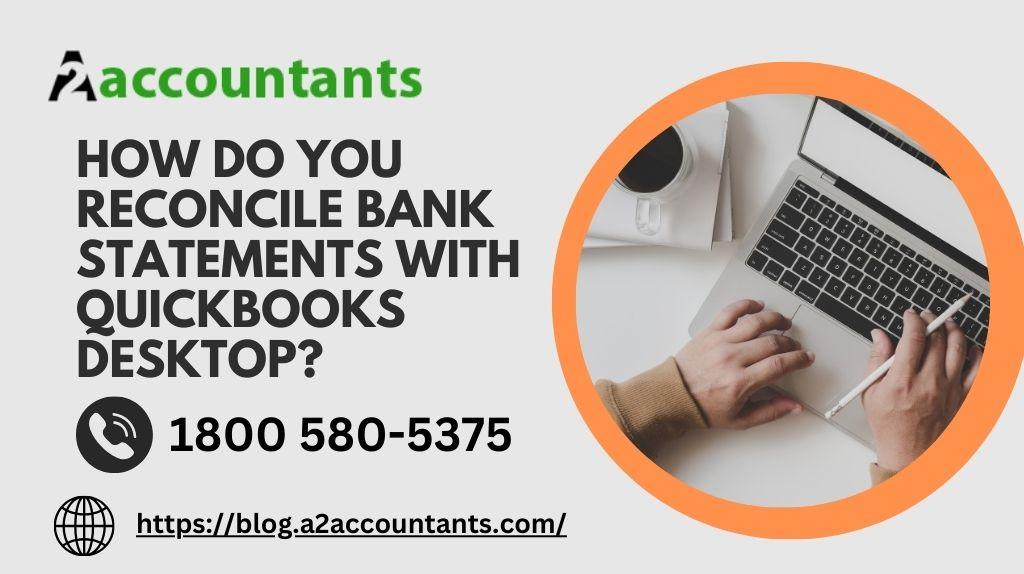A bank reconciliation declaration is drafted by a business that reflects its registered bank account balance equal to the balance of the bank register. Besides this, these statements add all financial transactions from a given time bracket, like deposits and withdrawals. Also, many businesses generate bank reconciliation statements regularly to ensure they have recorded all their banking transactions appropriately and that their ending balance matches the amount the bank says they have. Also, many business owners reconcile their bank statements but are unaware of how to get reconciliation reports in QuickBooks Desktop.
In this article, we will explain in depth how to reconcile in QuickBooks Desktop and get reconciliation reports in QuickBooks Desktop so that you can have a better experience doing reconciliation in QuickBooks.
What is the Target of a Bank Reconciliation Statement?
Bank reconciliation statements can assist in detecting accounting mistakes, differences, and fraud. For example, if the business’s records signal collections and deposits, yet the bank reports do not reflect such deposits, there may have been an error or fraud.
Generally, ensuring a business’s and its bank’s registers balance align is also a method to ensure the account has sufficient funds to cover business expenditures. Besides this, the technique facilitates the company to register any interest payments the report has generated or fees the bank has charged.
The reconciliation method lets a company know its cash flow and handle its accounts payable and receivable.
How to Do Bank Reconciliation Between Statements?
Before reconciling your business and bank records, collect your business ledger and the recent and previous bank statements. Generally, you can obtain a template online to utilize for your bank reconciliation statement, or you can use a spreadsheet.
1. Discover the Beginning Balance
If you compare each type of money, your beginning balance will be the final balance from the past months.
2. Check the Deposit and Withdrawals:
Inspect your ledger’s registered deposits, withdrawals, and cleared checks against those listed on the bank reports. Also, ensure all the amounts match up and investigate any differences. Everything registered on the bank statements must be added to your record.
3. Edit the Cash Balance
Beginning with your bank statement balance, include any deposits you have made that have not yet been visible. Likewise, withholding any checks that are not clear. Also, your result is in the edited cash balance. Besides this, adjust the cash balance to ensure your ledger’s credit and the bank report balance will be equal.
4. Account for interest and Fees:
Explore the bank statement for any claim your account generates during the month, then include it in your reconciliation statement. Besides this, any charges for fees the bank calculation that your ledger does not register.
5. Reconcile End Balances
After checking all deposits and withdrawals, editing cash balances, and accounting for interest and fees, your ledger’s complete balance must equal the bank statement balance. If the two proportions differ, you must search through everything to discover any difference. These could be your mistakes or the bank’s.
How Frequently Must You Reconcile Your Bank Account?
Generally, you must reconcile your bank account every time you get a statement from your bank. This is frequently done at the end of each month, weekly, and even daily by companies with many financial transactions.
Before the reconciliation method, companies must ensure they have recorded all financial transactions at the end of their bank reports. Generally, companies that use online banking assistance can download the bank statements for the regular reconciliation method instead of manually entering the details.
Who Conducts Bank Reconciliation?
Every business executes bank reconciliation, but the method differs depending on the size, number of bank accounts, and the difficulties of bank reports.
Generally, considerable businesses could have ten bank accounts for classifications like running, spending, and earning. Also, these accounts could be at ten individual banks or even methodically transferred between other business accounts. If done manually, this difficulty can be time-consuming and implies that the bank reconciliation methods take weeks to finish.
How do I get reconciliation reports in QuickBooks Desktop?
In this article section, you will learn how to get a past reconciliation statement to check your past reconciliation. Besides this, you require information from a past reconciliation to resolve your
recent reconciliation and understand how to get reconciliation reports in QuickBooks Desktop. Also, a previous reconciliation statement offers you details that can assist you in getting differences and other mistakes.
Run a Previous Reconciliation Statement
1. Press to the Report menu. Go to Banking, choose Previous Reconciliation
2. Press the account you reconciled from the Account drop-down menu.
3. Choose the reconciliation time you want to check in the Statement Ending Date
4. Choose Detailed or Both for the statement type. Details are suggested if you are utilizing the report to resolve a reconciliation.
5. Decide which transaction you want to watch on the report
Transactions cleared at the time of comparison: This offers you a snapshot. It only reflects transactions in the account at the time of the comparison.
The transaction cleared additional changes made to those transactions: It reflects transactions in the account when reconciliation. Besides this, it remembers where they recently are in your reports.
6. Go for Display when you are prepared to operate the report
It will assist to know how to get reconciliation reports in QuickBooks Desktop.
Who is Responsible for Bank Reconciliation?
If you do your bookkeeping, you must be prepared to reconcile your bank reports regularly. If you work with a bookkeeper or online bookkeeping assistant, they will manage it. Also, you must only reconcile bank statements if you apply an accurate accounting system. Generally, this ensures that all unclear bank transactions you registered went through. While you utilize cash-based accounting, you record every financial transaction at the same time.
time the bank does. Besides this, there must be no discrepancy between your balance sheet and bank reports.
In large businesses with full-time accountants, someone constantly reviews to ensure every number checks and that the accounting matches reality. In a small business, that duty usually falls to the owners if you hire one. Suppose you do not have a bookkeeper.
Crucial Phrase to Understand for Bank Reconciliation
Many explain the differences between a business’s bank statement and accounting register. Here are three things that have evolved into common phrases you can encounter at different backgrounds of a bank reconciliation:
Illustrative Check: An extended check is when a corporation has gotten but has not yet deposited in the bank or a deposit check that has not been cleared through the banking system.
NFS check: If a business tries to deposit a check from a client without the funds to cover the payment, the transaction fails.
Deposit in transit: After a business gets a charge, particularly in the formation of cash or review, it deposits the amount at the bank.
Read more:
Final Words
A bank reconciliation statement is essential in managing your business finances. This report can help ensure your bank account has enough balance to cover business spending. Also, it is a device for knowing your business’s cash flow and conducting accounts payable and receivable. Most companies know how to operate QuickBooks for reconciliation but are unaware of how to get reconciliation reports in QuickBooks Desktop. Reading this article can help you learn how to reconcile in QuickBooks Desktop and how to get reconciliation reports in QuickBooks Desktop.


![Ultimate Review: My Experience with [Name of Dune Buggy Tour Company]](https://www.takeneasy.com/wp-content/uploads/2023/12/Screenshot-3-150x150.png)
